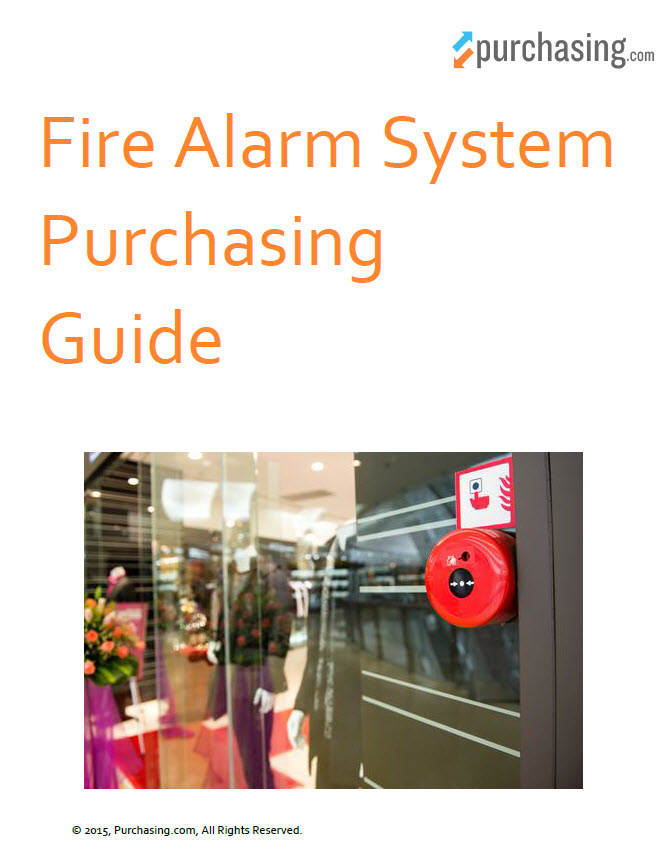Introduction to the Fire Alarm System Buying Process
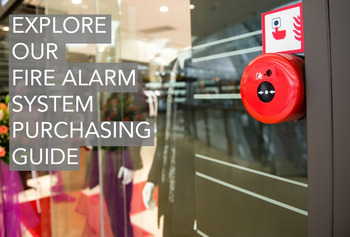 Table of Contents
Table of Contents
- Trends
- Types
- Devices
- Alerts
- Monitoring
- Choosing a Dealer
Introduction
Fire alarm systems are one of the most valuable components to any business. Protecting life, inventory, and property, they are required by law for companies operating throughout the United States and often provide discounts on insurance rates in some cases.
By necessity, no two systems are the same. Each is custom tailored and installed with specific business processes in mind. For example, a system engineered for a casino or lodge will be vastly different than one designed for a kitchen or facility housing large banks of mainframe computers. This focus on special circumstances is what elevates a fire alarm system from the basic smoke alarms available in hardware stores.
Basic design
Large buildings or commercial sites that support multiple structures, such as a retail strip mall or office complex, require extensive planning before fire alarm installation takes place to ensure the system performs as expected and meets all local fire codes and insurance requirements. In fact, many cities require a schematic layout of all components to be submitted and approved before installation.
Regardless of the size of your business, the fire alarm system must be spread throughout your facility with components such as lights, sirens, and detectors placed within a specific range of feet. Placing is determined by the dimensions of a room measured in square feet or the length of a corridor. Quantity is also determined by the individual luminosity of the lights. The function of a room and the equipment used within it - a stove or oven for example - further mandates placement of fire detection devices.
Modern systems are interconnected, alerting business owners and security personnel to danger and effectively directing fire crews when necessary. There are two different types: conventional and addressable. Each provides a very different level of protection and will be covered extensively in the Types section.
Purchasing checklist
Partnering with a professional dealer is the surest way to understand the regulation and installation of a fire alarm system and find the right equipment that can save valuable minutes in an emergency. Often able to help navigate local regulating agencies, fire alarm dealers greatly simplify the purchase process while ensuring the system is installed correctly and that it meets the specifics of your business.
To facilitate your conversation with a dealer, this purchasing guide provides an in-depth look at the types, devices, and monitoring services of a modern fire alarm system. As you read through, take note of how the following aspects apply to you:
- Types - Which type of alarm is best suited to your business: conventional or addressable?
- Components - Which component is considered to be the most important for preventing death and property damage?
- Monitoring - What is the role of a monitoring service and some of the advanced conveniences and functionalities it should provide?
- Codes and regulations - Know where to find national codes and how a dealer can help ensure compliance based on your building specs.
To get started, let's take a quick look at some of the recent and emerging trends shaping the industry today, as well as those that will continue to impact your purchase decision well into the future.
Back to top
Trends
Commercial fire alarm systems are triggered by a range of sensory or manually activated devices. They connect to a monitoring service and provide audible and visual alarms that alert people to danger. Within this setup, every component is affected by technology. And as technology continues to develop, new fire alarm systems become more sophisticated and effective in tandem - advancements that impact their performance as well as the codes that regulate them.
Here are some of the most popular developments that will affect your purchase decision.
Smart systems
Smart systems are designed to improve levels of detection while minimizing reminder alarms that indicate maintenance. Most incorporate a range of developments within the components themselves, including heightened sensitivity, drift compensations, and an indicator for maintenance required.
Equally beneficial to small buildings and large facilities alike, the technology isn't just limited to detection alone. Many now include better intelligibility in their audible signals, ensuring that the voice providing instructions in an emergency can be clearly heard and understood. This advancement requires improvements to the speakers and a design that constructs the fire alarm system around auditory impediments caused by poor acoustics such as reflection or reverberation.
Another aspect of many smart systems is the integration of a fire alarm with other systems. This expands the usefulness of the fire alarm system and allows it to save time in an emergency. A couple common examples include lighting and the integrity of fire doors. When integrated into a building's lighting system, unoccupied rooms can be darkened in an emergency, saving fire crews from having to search each room individually. When coupled with a security system, door indicators can provide visual cues as to whether the fire doors are functioning properly, greatly expediting inspection.
The final aspect of a smart system is its addressable nature, especially when it comes to sprinkler services. We'll cover the difference between a conventional and addressable fire alarm system in the next section. But for now, it's important to know that many addressable sprinklers that are part of a smart system make use of an addressable sprinkler head. This development is far more effective at quickly identifying the exact area affected. With previous models, a zone was triggered during detection and that zone could often encompass an entire floor. Smart system sprinklers are distinguished individually by a unique circuit card that provides a locating address for each sprinkler head. This setup also provides a range of new diagnostics that simplify restoring fire protection should the system go down.
Codes and regulations
Compliance is one of the focal points when buying a new system. And as technology improves, so too does the way in which is gets regulated. Unfortunately, a single resource providing everything you need to know is rare, if not impossible, as codes differ among each municipality - all the more reason to partner with a fire alarm dealer that has experience in your region.
Whether working with a dealer or interacting with the local fire marshal, you can expect to hear codes related to the NFPA 72 (the National Fire Protection Association's manual for commercial fire alarm installation), the Americans with Disabilities Act (ADA), and the Occupational Safety and Health Administration (OSHA). The guidelines provided by these organizations are continuously changing, a fact that is particularly true of the NFPA whose handbook is currently available in a 2013 edition and set to be updated again in 2016.
Again, each city is different. But some of the recent codes affected by technology include:
- Auditory alarms - Any fire alarm system installed in a building with a total occupancy of 500 people or more must be a voice/alarm communication system.
- Volume - Sound pressure provided by an alert device may not exceed 110 decibels (dBA).
- Self-contained and independent - Fire alarms must be able to operate independent of other building systems including building automation, energy management, and security.
- Dedicated electrical source - Fire alarm systems must be equipped with a hardwired mini-computer power conditioner that safeguards the system from all power surges as well as electrical noise.
- Wiring - All wiring must be copper and encased within conduit.
- Conduit - The conduit that houses fire alarm system wiring must be rigid metal or electric metallic tubing.
The above requirements were taken from guidelines by the U.S. General Services Administration. For a complete list of their codes and regulations, see: Fire Alarm Systems.
Back to top
Types
Understanding the difference between conventional and addressable fire alarms is relatively simple: addressable fire alarms pinpoint the exact area of alarm whereas conventional systems only identify a zone. While that may seem straightforward enough, there are actually a number of pros and cons that go with each type of setup, making them better suited to some locations than others. Here's how they compare.
Addressable fire alarm systems
An addressable fire alarm system uses circuit cards to connect each component to an identifying address. Similar to the IP address for your smartphone or laptop computer, this enables firefighters or technicians to quickly and precisely identify the exact location of the problem. Components are connected to the system via a wiring loop that begins and ends with the control panel.
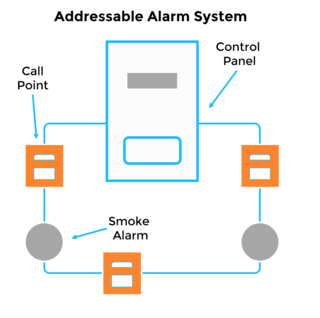 Addressable systems are mainly designed for larger facilities and campuses, providing quick access to a range of essential information from a central location. However, they can be effective in a smaller setting too. Depending on your needs and budget, their pros and cons could go either way:
Addressable systems are mainly designed for larger facilities and campuses, providing quick access to a range of essential information from a central location. However, they can be effective in a smaller setting too. Depending on your needs and budget, their pros and cons could go either way:
 Centralized controls: Control panels provide the status for every device linked into the system, easily monitoring and managing all components from a centralized area.
Centralized controls: Control panels provide the status for every device linked into the system, easily monitoring and managing all components from a centralized area.
 Pre-alarm warning: Enables administrative staff to investigate the problem before the main alarm sounds, avoiding false alarms and unnecessary disruption.
Pre-alarm warning: Enables administrative staff to investigate the problem before the main alarm sounds, avoiding false alarms and unnecessary disruption.
 Easy upgrades and additions: Loop wiring simplifies upgrades, providing quick access for the addition of new or extra components without having to run any additional wiring.
Easy upgrades and additions: Loop wiring simplifies upgrades, providing quick access for the addition of new or extra components without having to run any additional wiring.
 Customizable: Addressable components can be tailored to the specifics of a unique location, adjusting the alarm threshold for smoke in a kitchen or heat in a manufacturing facility.
Customizable: Addressable components can be tailored to the specifics of a unique location, adjusting the alarm threshold for smoke in a kitchen or heat in a manufacturing facility.
 Reliability: If a component becomes disconnected or its wiring is severed, the rest of the system remains operational.
Reliability: If a component becomes disconnected or its wiring is severed, the rest of the system remains operational.
 Expensive: By some estimates, addressable systems can cost anywhere from 50% to 100% more than their conventional counterparts, but that cost comes with a wide range of additional functionality ranging from detection to diagnostics.
Expensive: By some estimates, addressable systems can cost anywhere from 50% to 100% more than their conventional counterparts, but that cost comes with a wide range of additional functionality ranging from detection to diagnostics.
 Complicated installation: Installation features a single loop that connects the entire system, using less wiring than a conventional setup but remaining more complex overall due to the system-wide integration of all components.
Complicated installation: Installation features a single loop that connects the entire system, using less wiring than a conventional setup but remaining more complex overall due to the system-wide integration of all components.
Conventional fire alarm systems
Far from old-school, conventional fire alarm systems make use of the latest detection and alarm components, each wired individually into a central control panel. As explained in the introduction, a conventional fire alarm system only identifies an alarm within a "zone." This makes them well-suited to a single retail shop, restaurant, or smaller location with limited square footage.
At the same time, this design makes conventional systems ill-suited to large office complexes and other facilities. Each room within the zone would have to be searched to locate the source of the alarm - a time-consuming process that could lead to more extensive property damage and loss of life.
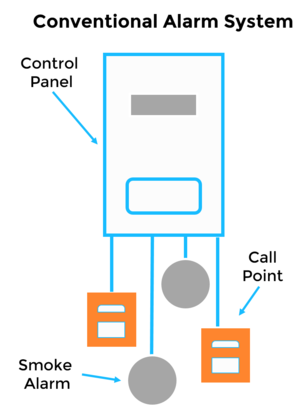 Sometimes referred to as a "zoned system," a conventional alarm usually monitors a minimum of 2 to 4 zones and can accommodate up to 36 of them with deluxe control panels like those manufactured by Siemens. Every zone supports about 20 detection devices on average, further illustrating its incompatibility with a large floor plan. But within a small setting, many installations wire their zones separated by walls or, in a multistory building, by floor.
Sometimes referred to as a "zoned system," a conventional alarm usually monitors a minimum of 2 to 4 zones and can accommodate up to 36 of them with deluxe control panels like those manufactured by Siemens. Every zone supports about 20 detection devices on average, further illustrating its incompatibility with a large floor plan. But within a small setting, many installations wire their zones separated by walls or, in a multistory building, by floor.
Similar to addressable systems, the pros and cons of a conventional setup could go either way depending on your unique situation:
 Cheaper control panel: For a conventional model, you can expect to pay about half the cost of an addressable control panel, with conventional models ranging between $300 and $700 and addressable panels starting around $500 and going well above $1,500.
Cheaper control panel: For a conventional model, you can expect to pay about half the cost of an addressable control panel, with conventional models ranging between $300 and $700 and addressable panels starting around $500 and going well above $1,500.
 More cost-effective overall: Conventional systems cost 50% to 100% less than their addressable counterparts.
More cost-effective overall: Conventional systems cost 50% to 100% less than their addressable counterparts.
 More work to install: With each type of component requiring a separate zone: pull stations on one, smoke detectors on another for example: each device gets its own run, costing extra for the labor involved in wiring them all together.
More work to install: With each type of component requiring a separate zone: pull stations on one, smoke detectors on another for example: each device gets its own run, costing extra for the labor involved in wiring them all together.
 Not as inclusive: Addressable models feature additional detection sensors such as airflow monitors that can actually save you money in certain cases. Conventional systems trigger an alarm throughout the zone when it detects smoke from a single source: burned popcorn in a community microwave for example. The cost savings is realized in the avoidance of false alarms which can cost you anywhere from $57 to $233 per quarter hour depending on the level of emergency response.
Not as inclusive: Addressable models feature additional detection sensors such as airflow monitors that can actually save you money in certain cases. Conventional systems trigger an alarm throughout the zone when it detects smoke from a single source: burned popcorn in a community microwave for example. The cost savings is realized in the avoidance of false alarms which can cost you anywhere from $57 to $233 per quarter hour depending on the level of emergency response.
 Broad search area: Not a big deal in a relatively small setting, but a huge disadvantage for large areas.
Broad search area: Not a big deal in a relatively small setting, but a huge disadvantage for large areas.
Devices and Components
 A fire alarm system is only as effective as its components. And while some systems come packaged, many others are built custom by a dealer. These are often designed to meet the specifics of a company and even individual areas within the facility.
A fire alarm system is only as effective as its components. And while some systems come packaged, many others are built custom by a dealer. These are often designed to meet the specifics of a company and even individual areas within the facility.
Before talking to a dealer, familiarize yourself with the common devices and components covered below.
Detectors
Capable of detecting far more than just smoke, modern detectors factor in a range of indicators before triggering an alarm. The three most popular types include:
- Smoke detectors: This is a subcategory that is further broken down into two options: ionization and photoelectric.
- Ionization smoke detectors are a general model that's designed for detecting flames. One of the most common, it's found in kitchens, office buildings, and an endless variety of other locations.
- Photoelectric: This type is a step up from ionization models though it serves a slightly different purpose. Using reflected light, it can detect smoke in the air that originates from great distances, often the result of a smoldering fire. Similar to an ionization detector, these are common throughout facilities of every industry and are often used in combination with one another to provide the greatest level of protection, especially in high value areas. Costs typically range from $60 to $70 per unit but can go as high as $2,400 each for advanced models.
- Heat detectors: Unlike smoke detectors, heat detectors are not an early warning device. They are designed mainly to protect physical property and stored merchandise. Commonly found in historic sites, warehouses, and locations that don't have a continuous human presence, heat detectors are not compatible with locations that have heat fluctuations: industrial kitchens and certain manufacturing facilities for example. Costs range from $11 to $150 on average, with high-end models available for $2,000 to $2,400.
- Flame detectors: Using infrared and ultraviolet technology, flame detectors are mainly for signaling alerts to large-scale fires, including explosions. They are designed to serve as an extra layer of hazard protection for industrial applications like those found on oil rigs and refineries or within aerospace manufacturing. Often sensitive to sunlight and even welding flames, their position and use has to be exact, with installation that requires an unobstructed vantage point of the area they're monitoring. Costs run in the $2,800 to $3,000 range per unit.
Fire alarm control panels
Serving as the hub of all components that make up the system, fire alarm panels receive alerts from initiating devices and activate an alarm, sending notification to the monitoring service, specified personnel, or both. Similar to a standard computer in many respects, the control panel has a micro-processor that's programmable within the functionalities of the system and should include a built-in surge protector that safeguards it from power fluctuations.
Fully networkable, standard models can accommodate 600 or more total devices, with more than 150 detectors, and come with one signaling line circuit, which is easily upgraded to two if desired. Conventional models cost between $300 and $700. Addressable panels start around $500 and go well above $1,500 depending on customizations and the size of the system it supports.
Sprinkler systems
Frequently considered to be the most important component for preventing death and property damage, some cities require all commercial buildings to be equipped with a sprinkler system. But according to the NFPA , they're still somewhat rare overall, with only 36% of schools and universities and only 24% of stores and offices having a sprinkler system in place. Almost always custom-tailored to each individual setting, they are constructed from a variety of parts including:
- Alarm valve that controls the flow of water (also known as a flow valve)
- Sprinkler heads that active in high heat and restrict the spray of water to a certain area
- Alarm test valve that runs a test on the pump without activating the heads
- Stop valve that prevents the flow of water into the system
- CPVC pipe to carry water throughout the system
As each installation is custom tailored, costs will vary by location. In general, you can expect to spend up to $2 per square foot for new construction and $4 to $10 per foot for retrofitting an existing facility.
Boxes
Fire alarm boxes provide a convenient location for employees or other individuals to trigger an alarm or call for help. Most frequently found on large campuses, they're somewhat rare in an office setting as most fire alarm systems include pull stations that are mounted to the wall.
Boxes are bright red and sometimes designed with a miniature pitched "roof." Surface mounted, they come in a variety of shapes and sizes and can easily be installed onto the side of a building or light post. Depending on the level of style involved, expect to pay anywhere from $60 to $300 per box.
Back to top
Alerts
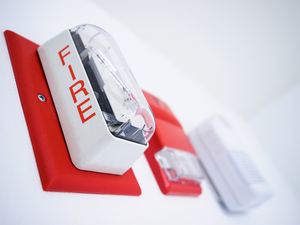 When an alarm is triggered, there are a number of different methods for notifying those in the building of danger. These may include one or more of the following.
When an alarm is triggered, there are a number of different methods for notifying those in the building of danger. These may include one or more of the following.
Bells
Powered by a 12- or 24-volt DC current, bells are only designed for areas where they can be clearly distinguished from similar sounds. A school, for example, would not use this type of notification as it would be too close to the bells that signal a change in classes.
Ranging in size from 4 to 12 inches in diameter, gong size dictates the level of sound they provide. The loudest signals are provided by those with the widest gong diameters. Average cost ranges from $30 to $100 per unit.
Horns
Far more common than a bell, this type of alarm provides a louder and far more distinct style of alert. Found in almost every office building and industrial facility in the world, horns come in a variety of shapes and sizes, including surface-mounted, flush-mounted, and semi-flush mounted, not to mention trumpet style.
Typically red in color, they provide notification through either continuous vibration or electronic signal. Elevating them above a single type of notification, this allows them to provide a range of different coded alarms, one for evacuation and another for all clear for example. Many models include built-in strobe lights, though not always. Costs range from $20 to $190 per unit depending on the make and model.
Sirens
One of the most effective levels of alert is provided by sirens, though they are almost exclusively relegated to emergency notification. In general, sirens are often mounted to the exterior of buildings or used within loud environments such as machine shops or other facilities that run noisy machinery.
They're powered by either a motor-driven or electronic core. You'll pay anywhere from $60 to $150 per unit depending on style and output.
Strobe lights
Strobes emit a high intensity flash of light in short durations that signals alarm. In some cases, the flashes are emitted in sequence to guide people to the nearest exit. Strobe lights are incorporated into fire alarm systems for a couple of different reasons, the first of which is to get attention. In large manufacturing facilities or areas where employees wear hearing protection, an audible alarm may not be enough to notify everyone of danger. The quick successive burst of a strobe light quickly grabs attention in almost any setting. The second reason they're used is to direct people during low-visibility situations, a smoke-filled room being a common example.
Strobe lights are available in a wide range of intensities and as a wall- or ceiling-mounted unit. It's worth noting that if you have a large area, you will be required to either have a greater quantity of lights interspersed throughout the floor plan or fewer lights that emit higher intensity flashes. On average, you can expect to pay $30 to $50 per unit on the lower end and $80 to $160 for high-end models that also typically include a built-in horn.
Back to top
Monitoring
Monitoring stations play a large part in the timely response and overall effectiveness of the system. That makes them a significant consideration in your purchase decision.
When your alarm is triggered, the control panel sends details on the alert to a fire alarm monitoring station. In turn, monitoring stations notify the fire department and may also notify certain personnel designated in advance – a critical feature used after normal business hours.
Providers
The market for fire alarm monitoring is relatively widespread. A range of companies such as Guardian Alarm, Cintas, and Western States Fire Protection provide services for commercial properties and large-scale organizations throughout the United States. Larger providers may have centralized monitoring services that keep tabs on businesses within a certain area. But for the most part, many companies outsource this aspect of an alarm system to a third-party monitoring station.
In addition to providing emergency response, these companies are required by law to monitor and track the activity and functionality of your system in case authorities want to review incident details. Regardless of their proximity to your location, a monitoring service is required to contact emergency personnel within 30 to 60 seconds of receiving alarm notification. To ensure the continuance of service in the event of a flood, earthquake, power outage or a similar widespread disaster, these services are also required to have a reliable backup source for service, either a second monitoring station or a generator that can provide at least 10 days of reserve power.
- Purchasing tip: Fire alarm monitoring services are not always necessary. Some municipalities require your fire alarm to be directly connected to your local fire department, eliminating the go-between. If you’re unsure which applies to you, ask your dealer.
Hard wired or wireless connection
Your fire alarm system is connected to the central monitoring station in one of two ways: phone lines or wirelessly. With the hard wired option, two separate, dedicated phone lines link the control panel to the monitoring service. In situations where hard wired boxes are inefficient or too costly, wireless technology connects the control panel to the service via the web. Despite this being a newer means of connection, many quality services are UL listed and reliable.
Choosing the best service
Evaluate the monitoring services you’re comparing by checking their status and individual ratings with the Electronic Security Association (ESA), your local state regulatory board, and the Better Business Bureau. Take note of any complaints filed, how they were resolved, and how quickly.
The independent Underwriters Laboratories (UL) has also established standards for monitoring station equipment and procedures. As mentioned in the section on wireless services above, companies that provide UL-rated monitoring have demonstrated their compliance with UL guidelines for safety and reliability.
Estimated costs
Costs vary depending on the type and level of service. For example, some companies offer monitoring services with remote interactive capabilities that allow you to manage your alarm system via the web or with your smartphone for $30 per month.
In general however, you can expect to pay $50 to $60 per month for many of the proven name brands that operate nationally. This fee often includes routine inspections to ensure all components are working and that the system is functioning correctly, as well as a range of 24/7 support features. Most of these services require a three-year service contract at minimum.
Back to top
Choosing a Dealer
Fire alarm system dealers range from large corporations with a dedicated sales force to independent resellers that install systems belonging to a number of different companies. Whichever you choose must be certified by the National Institute for Certification of Engineering Technologies (NICET). This certification covers system layout, equipment selection, installation, and a variety of service-related and trouble-shooting issues. It ensures the provider you select possesses a complete understanding of nationally-enforced safety and installation requirements. Also make sure the companies you’re considering are fully licensed to install fire alarm systems within your area.
And never choose a dealer that offers a quote sight-unseen. Reputable companies provide an initial assessment on-site or, at the very least, review blueprints of your facility to determine the best system design.
- Purchasing tip: Companies that offer all-inclusive services – encompassing site assessment, installation, wiring, and monitoring – may be able to provide a high degree of value. Not only are they familiar with every component in the system, they may also be able to offer better rates through a package deal. Those that can provide integration with other security systems are even better (though it’s worth noting that doing so could cause glitches with software compatibility down the line).
Support
Electronic devices can malfunction. And fire alarm systems that run on a propriety software platform add another level of complication to the system. Whether it’s a faulty horn or a software update that creates a glitch in the system, reliable support is a must if you hope to prevent business disruption. For this reason, there is a specific checklist to run through for any dealer you’re considering to make sure they provide a level of service comparable with your needs.
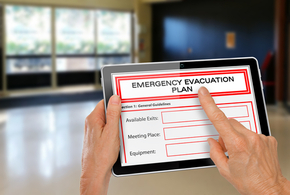 These issues include:
These issues include:
- What are their customer service hours?
- Is central monitoring provided in-house or do they sub-contract with a third party provider?
- How quickly can you reach a live service rep on the phone?
- Is there a guaranteed response time for repairs?
- How quickly can a technician be at your location?
- How often do they inspect the system and all of its components?
Get Quotes
- We contact sellers
- They compete for your business
Training and assistance
Given the extensive wiring involved, installing a system often represents a large portion of the total cost. Some providers try to offset this by providing additional support in the form of specialized instruction and training. Depending on what it includes, it could be well worth it.
Three of the most popular support services are:
- Creating an emergency plan: Some dealers offer their expertise in floor plan layout to help construct an evacuation plan that includes specific routes and assembly areas. This form of training often involves senior management and a designated floor supervisor or volunteer emergency personnel from your staff.
- Staff training: Employee training and education is another one of the key components to safety. Some dealers may offer in-house workshops that address things like: individual responsibilities in an emergency, hazards and protective responses, the location of pull stations and all other manually activated equipment, emergency shutdown procedures, and the evacuation plan. These trainings inform employees on how to respond quickly and effectively and can easily prevent injuries and fatality.
- Codes and regulations: As mentioned in the Trends section above, there are numerous organizations that regulate the design and installation of fire alarm systems. A quality dealer will have working knowledge of the codes specific to your region and should be able to guarantee compliance.
